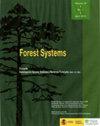高山林和大蓟科植物种子形态生理休眠水平不同,有助于其适应不同的生境
IF 0.7
4区 农林科学
Q3 FORESTRY
引用次数: 0
摘要
研究目的:研究两种稻属植物的萌发生态学,揭示其形态生理休眠(MPD)水平,为种子转化成植物提供依据,为种群强化提供重要工具。研究领域:实验在阿尔巴塞特(西班牙)的室外和实验室进行,实验的种子来自经向伊比利亚系统山脉。材料和方法:用数年的时间收集了一个阿尔卑斯部落和另一个crispa部落的种子。通过分析MPD对胚长、胚根和幼苗出苗率的影响以及对分层和GA3萌发的影响来确定MPD水平。主要结果:高山参鲜种子胚长为0.49 mm,萌发需长至1.30 mm。温分层(25/10ºC)使胚长增大至0.97 mm。之后,种子在很宽的温度范围内发芽。胚胎生长和出苗发生在夏末秋初。鲜种子胚长为0.52 mm,为萌发的最小胚长2.10 mm。胚胎暴露于中等温暖的分层(20/7ºC + 15/4ºC),然后是寒冷(5ºC),生长到2.30毫米。当温度≥15/4℃时,种子萌发率≥80%。胚胎在秋季/初冬生长,幼苗在冬末/早春萌发。研究重点:这些结果表明,高冬种子具有非深层的简单MPD,而紫薯种子具有非深层的复杂MPD。此外,每种物种的不同发芽模式有助于解释它们在不同栖息地的安装。关键词:酷栗;种子休眠中断;胚根出现;幼苗出现;非深度简单MPD和非深度复杂MPD。使用的缩写:形态生理休眠(MPD),形态休眠(MD),赤霉素酸(GA3),月(m)。本文章由计算机程序翻译,如有差异,请以英文原文为准。
Different levels of morphophysiological seed dormancy in Ribes alpinum and R. uva-crispa (Grossulariaceae) facilitate adaptation to differentiated habitats
Aim of the study: To study the germination ecology of two species of the genus Ribes to reveal their levels of morphophysiological dormancy (MPD) and to facilitate the production of plants from seeds, a key tool for population reinforcement.Area of study: Experiments were carried out both outdoors and in the laboratory in Albacete (Spain) with seeds from the Meridional Iberian System mountain range.Material and methods: Seeds from one population of Ribes alpinum and from other of Ribes uva-crispa were collected during several years. Embryo length, radicle and seedling emergence, and effects on germination of stratification and GA3 were analysed to determine the level of MPD.Main results: In R. alpinum, embryo length in fresh seeds was 0.49 mm, needing to grow to 1.30 mm to germinate. Warm stratification (25/10ºC) promoted embryo length enlargement to 0.97 mm. Afterwards, seeds germinated within a wide temperature range. Embryo growth and seedling emergence occur late summer-early autumn. In R. uva-crispa, embryo length in fresh seeds was 0.52 mm, being 2.10 mm the minimal size to germinate. Embryos exposed to a moderately warm stratification (20/7ºC + 15/4ºC) followed by cold (5ºC) grew to 2.30 mm. Then, seeds germinated ≥ 80% when incubated at temperatures ≥ 15/4ºC. Embryos grew in autumn/early winter, and seedlings emerged late winter-early spring.Research highlights: These results showed that R. alpinum seeds have a nondeep simple MPD while R. uva-crispa seeds have a nondeep complex MPD. Moreover, the different germinative models found for each species help explain their installation in distinct habitats.Keywords: Ribes; seed dormancy break; radicle emergence; seedling emergence; nondeep simple and nondeep complex MPD.Abbreviations used: Morphophysiological dormancy (MPD), morphological dormancy (MD), Gibberellic acid (GA3), months (m).
求助全文
通过发布文献求助,成功后即可免费获取论文全文。
去求助
来源期刊

Forest Systems
FORESTRY-
CiteScore
1.40
自引率
14.30%
发文量
30
审稿时长
6-12 weeks
期刊介绍:
Forest Systems is an international peer-reviewed journal. The main aim of Forest Systems is to integrate multidisciplinary research with forest management in complex systems with different social and ecological background
 求助内容:
求助内容: 应助结果提醒方式:
应助结果提醒方式:


